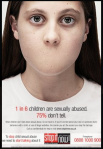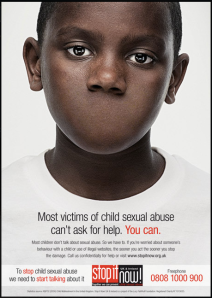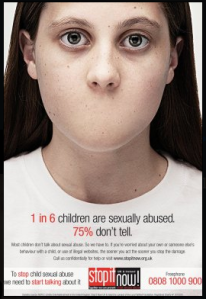 Disclosing sexual abuse is difficult on so many levels. Kids may have been threatened or bribed. They may be worried that the abuse is their fault and that they will get in trouble. They may fear that they won’t be able to live at home any more, that it will cause divorce or the breakup of a parent’s relationship, or that someone they care about will be put in jail. Confusion, shame, and fear are powerful, silencing feelings. And children may just not have the words, know what to say, or how to say it. We need to teach kids the importance of telling, but we also need to teach them how to tell.
Disclosing sexual abuse is difficult on so many levels. Kids may have been threatened or bribed. They may be worried that the abuse is their fault and that they will get in trouble. They may fear that they won’t be able to live at home any more, that it will cause divorce or the breakup of a parent’s relationship, or that someone they care about will be put in jail. Confusion, shame, and fear are powerful, silencing feelings. And children may just not have the words, know what to say, or how to say it. We need to teach kids the importance of telling, but we also need to teach them how to tell.
In a previous post, Using Data to Teach About Sexual Abuse Prevention, I wrote about how you can use data to (1) help kids understand that the greatest risk of sexual abuse is with people they already know, and (2) reach out to kids who may themselves be abusing other kids, and encourage them to ask for help. In subsequent posts I will talk more about how to teach kids about grooming behaviors, and share resources that you can use to develop your own sexual abuse prevention lessons or units, and materials that you can provide to school staff and parents. In response to a number of messages I received, I will also be sharing the personal safety lessons that I teach K-5. This may take me a while to pull together – currently my office consists of a wet carpet and a mountain of furniture stacked in the corner – but I will try my best to share all of these lessons during the next couple of months. In the meantime, here are the concepts and skills I focus on in all of my sexual abuse prevention lessons, regardless of age or grade level.

This striking image is from a sexual abuse prevention campaign in the UK.. I was not able to locate the original link, but wanted to share it because of how extremely powerful the picture of a child without a mouth is.
Identifying trusted adults, both in and out of school. Kids are often quick to rattle off a list of adult names, so I point out that just because you know somebody doesn’t mean you would want to talk to them about something uncomfortable (The custodian who you only ever say hi to? Really?). I ask them to give names (not just “grandmother” but “Nana”), make sure that it’s someone that they see regularly, and that any siblings/cousins they list are 18 or over.
Your body belongs to you and you get to say who touches it. Your whole body. That includes someone wanting to hold your hand or lean their leg on you at circle time. Beginning the conversation with this concept is a great way to lay the groundwork for sexual abuse prevention lessons for young children. I revisit the concept every year, but it takes a back seat for a few years – until you get some peer pressure about hugging or kissing an unsuspecting crush in 3rd, 4th, or 5th grade, then it’s back to the drawing board from a new developmental perspective!
It’s important to let them know that occasionally a doctor/nurse (at their office/hopsital) or parent might need to check their private parts if they have a rash, are having trouble going to the bathroom, or something is hurting them, but in that case it would be a quick thing and, although kind of embarrassing, would never be a secret.
The private parts of your body are the parts of the body that are covered by a bathing suit. Straightforward and easy to remember. The sexual abuse prevention community feels quite strongly that we should be teaching the correct anatomical terms, but I haven’t done so in a classroom setting. I don’t want parents to get so up in arms about the words that there’s a big fuss and kids end up getting pulled from important sexual abuse prevention lessons. I may change my mind some day, but haven’t so far.
Older kids or teenagers or adults who touch the private parts of a kid’s body know that it’s wrong and they don’t want to get caught, so they try to trick kids! Kids really get the idea of “tricking” and this is a good way to help them understand how grooming works. It also helps them understand that these situations are complicated and that someone might be an adversary without them realizing it. Although I don’t explicitly make the connection for kids, I incorporate tricking into my lessons. When I give scenarios for them to respond to or role plays for them to act out, I say things like, “Hmm, I’m trying to think of a tricky one. . . ” “This one is going to be really hard!” “Do you want a tricky one?” and, toward the end, “I can’t trick you guys at all!” At the conclusion of the class I tell the teacher, “They really know what to do if someone touches the private parts of their body or makes them touch someone else’s private parts! I tried really hard to trick them, but I couldn’t!”
No secrets about touching! If someone tells you to keep a secret about touching, that’s a clue to tell! I use the word “clue” because it indicates that abusive situations are often confusing and difficult to sort out. I give scenarios to the kids that all have the same answer – “Tell an adult you trust!” Here are a few examples:
What should you do if an older kid or teenager or adult . . .
- touches the private parts of your body?
- tries to touch the private parts of your body but you stop them?
- makes you touch the private parts of their their body?
- tries to make you touch the private parts of their body but you don’t?
- tells you not to tell?
- says they will hurt you if you tell?
- made you promise not to tell?
- gave you a present or money so you wouldn’t tell?
- says it’s a special secret just between the two of you?
- says that nobody will believe you if you tell?
- says that you won’t be able to live at your house anymore if you tell?
- says that all kids do this but none of them talk about it?
- says that you will get in trouble if you tell?
- did this to you a long time ago, but it’s not happening any more?
- it didn’t actually do it to you, but your friend told you that it happened to him/her?
Someone will undoubtedly call out, “You always tell!” to which I respond, “You’re right! I can’t trick you guys at all!”
Trust your yucky feelings. If you’re having yucky or uncomfortable or mixed up feelings, that’s a clue that you need to tell a trusted adult. Yucky feelings are your brain’s way of telling you that something is wrong or unsafe. I ask if they’ve ever had yucky feelings about something and almost everyone always says that they have. I tell them that my brain sends a signal to my stomach and that I usually feel my yucky feelings in my belly. Then I ask them where they feel their yucky feelings.
Sexual (or physical) abuse is not your fault. This needs to be said over and over. It is hard for some kids to grasp this concept, and you need to be quite specific about it. I give scenarios to the kids that all have the same answer – “No!”
- Is it the kid’s fault if someone touched the private parts of her body?
- Is it the kid’s fault if someone made him touch the private parts of their body?
- Is it the kids’ fault if someone touched the kid’s private parts or made the kid touch their private parts and . . .
- the kid didn’t tell them “No?”
- the kid promised that she wouldn’t tell?
- the kid kept it a secret for a long time?
- the kid didn’t try to get away?
- the kid took a present or money from the person who touched him?
- the person who did it tells the kid it’s her fault?
- an adult the kid tells about the touching says it’s the kid’s fault?
- the kid wasn’t supposed to hang out with the person who touched them?
- the kid wasn’t supposed to be where the touching happened?
- it didn’t actually hurt?
After a bit, kids will notice a pattern and call out, “The answer is always no!” Again, I say, “You’re right! I can’t trick you guys at all!”
The best way to stop sexual abuse is to tell a trusted adult about it. This is not a problem that kids can solve by themselves and they need adult help. It doesn’t stop just because a kid wishes it will stop. People who sexually abuse kids often do it to more than one kid. When a kid tells about someone sexually abusing them they help themselves and other kids that the person might try to touch.
If you tell but the abuse keeps happening, tell another trusted adult. Keep telling until the abuse stops! I have kids practice this. See below.
Adults at school MUST get help for kids who tell them about sexual abuse. It’s the law and they could get in trouble and lose their jobs if they don’t! No matter where you go to school – preschool, elementary school, middle school, high school anywhere in the country, someone at your school will always know how to help you.
There are lots of ways you can tell. Don’t worry if you’re not sure how to tell. Just take the first step. It’s the adult’s job to listen and figure out what you’re trying to tell them.
- Say, “I have something to tell you but I don’t know how to say it”
- Draw a picture
- Write a note that says, “I need to talk” or “I need help”
- Write a note that tells the whole story
- Close your eyes or turn your back and tell
- Just tell what happened
- Use a puppet or stuffed animal to do the telling
- Start by just talking about the feelings you are having
Unfortunately, sometimes kids are sexually abused, but there are adults who know what to do to help them. I know what to do. Your teacher knows what to do. She might help you herself or she might ask me to help. Your parents and other people outside of school might know what to do or they might not know what to do. That’s why sometimes you have to tell more than one adult. Someone at school will always know what to do.
Practice, Practice, Practice. Role playing is key if you really want to help kids build skills. I have younger kids practice telling an adult that someone touched the private parts of their body, had the kid touch the private parts of their body, tried to touch them, etc. I have every child take a turn – they get up, choose either their classroom teacher or me, and then tell. The teacher or I respond with, “Thank you for telling me. I’m sorry that that happened. I’m going to get some help.” I also have them practice what to do if the first person doesn’t believe them. They choose either me or the teacher to tell first, and we respond with something dismissive like, “Don’t tattle,” or “I don’t have time now,” or “That’s not true!” The student then goes to the second adult and tells again. The second adult responds with the “I’m going to get some help” reply. With the older kids we talk a lot about how hard it is to tell and why, and strategies for getting past those obstacles. They also practice telling, verbally or by note, encouraging a friend to tell, and telling on behalf of another kid.

This striking image is from a sexual abuse prevention campaign in the UK.. I was not able to locate the original link, but wanted to share it because of how extremely powerful the picture of a child without a mouth is.
Thanks for all you do to help prevent and respond to sexual abuse! It is not an easy topic to teach, and the subject matter can bring up a lot of difficult emotions, not just for the kids and teachers who experience your lessons, but for you as well. Make sure you take good care of yourself! Coming soon: materials to use when teaching kids how to tell, teaching kids about grooming, self-care, and resources for you to use in developing your own sexual abuse prevention lessons and units, and to share with parents and/or other educators.
I’d love to hear about how you teach kids about sexual abuse prevention! It’s such a challenging topic to teach and good resources can be hard to find. Wouldn’t it be great if we could develop a one-stop resource that school counselors and others could consult as needed?!!! Any ideas?
You might also be interested in . . .
A Collection of Sexual Abuse Prevention Resources
Teaching Kids to Recognize Grooming
“I Got Safe So Quickly!”: How Kids Feel After Telling About Sexual Abuse
Using Data To Teach About Sexual Abuse Prevention
Coloring Book Helps Kids Learn About Sexual Abuse Prevention

I’ve also used A Terrible Thing Happened by Margaret Holmes. This is such a tough topic; thanks SO much for helping us with ideas on how to address it with sensitivity.
Another great post on this topic! Thank you so, so much!
I like showing children a real dollar and a play money dollar to explain the difference in real and make believe “love”. Also, I use a variety of fishing lures to demonstrate the various types of lures that pediphiles use to get children to go along with their abusive acts.
I’m looking forward to seeing the materials you use with different age groups and the lesson plans to go along with this difficult topic. Thanks so much for the info.
Hey, thanks for such a wonderful piece. Im a nursing student! im going to take a session on educating about child abuse in upcoming week! the session is going to be with a the kids of about 6 to 10 years of age. can you please guide me about what sort of strategies i can use in this regards??